
A Venetian gondolier moves his flat-bottomed craft along the water as the sun lights the sky with a fiery glow. One of the city’s most famous churches, the Basilica de Santa Maria della Salute is in the background.

There is no one defining feature of Venice — it is a city with many distinctions. And for good reason it is considered to be the most beautiful canal city in the world.
The very idea of Venice is an improbable notion: a collection of 118 small islands sloshed by a brackish lagoon, transected by 150 canals, connected by 400 bridges, and with massive stone and brick buildings perched atop hulking wood pilings driven deep into mud. What began as a refuge from marauders became one of the wealthiest cities in the world and is today among the most popular tourist destinations on Earth. This marvel of resolve and ingenuity has thrived since the days of the Roman Empire.

St. Mark’s Square and St. Mark’s Basilica are among the many iconic sights in Venice. St. Mark’s was chosen as the city’s patron saint.

Of all the cities in the world, there is only one Venice, Italy, a place of architectural beauty and one-of-a-kind sights. It is a city that every serious traveler wants to visit.
Venice is located in the Italian region known as the Veneto, at the northwestern-most reach of the Adriatic Sea. The northern land region of the Veneto includes a portion of the Alps; they transition to gently sloping fertile lands suitable for farming and raising livestock. The waters of the Adriatic offer plentiful stocks of fish and seafood. But productive lands and waters were also territories to be conquered by marauding tribes of ancient Celts, Visigoths, Huns, Byzantines, and others. Sometime around 160 AD, to avoid slaughter or enslavement, the farmers and fishermen took their families and fled to the marshy islands off the coast.

In the distance is the San Michele Cemetery, opened in the 19th Century. There is a ferry stop to the island and a water hearse is used to transport caskets. In the foreground a green garbage barge makes its way along.
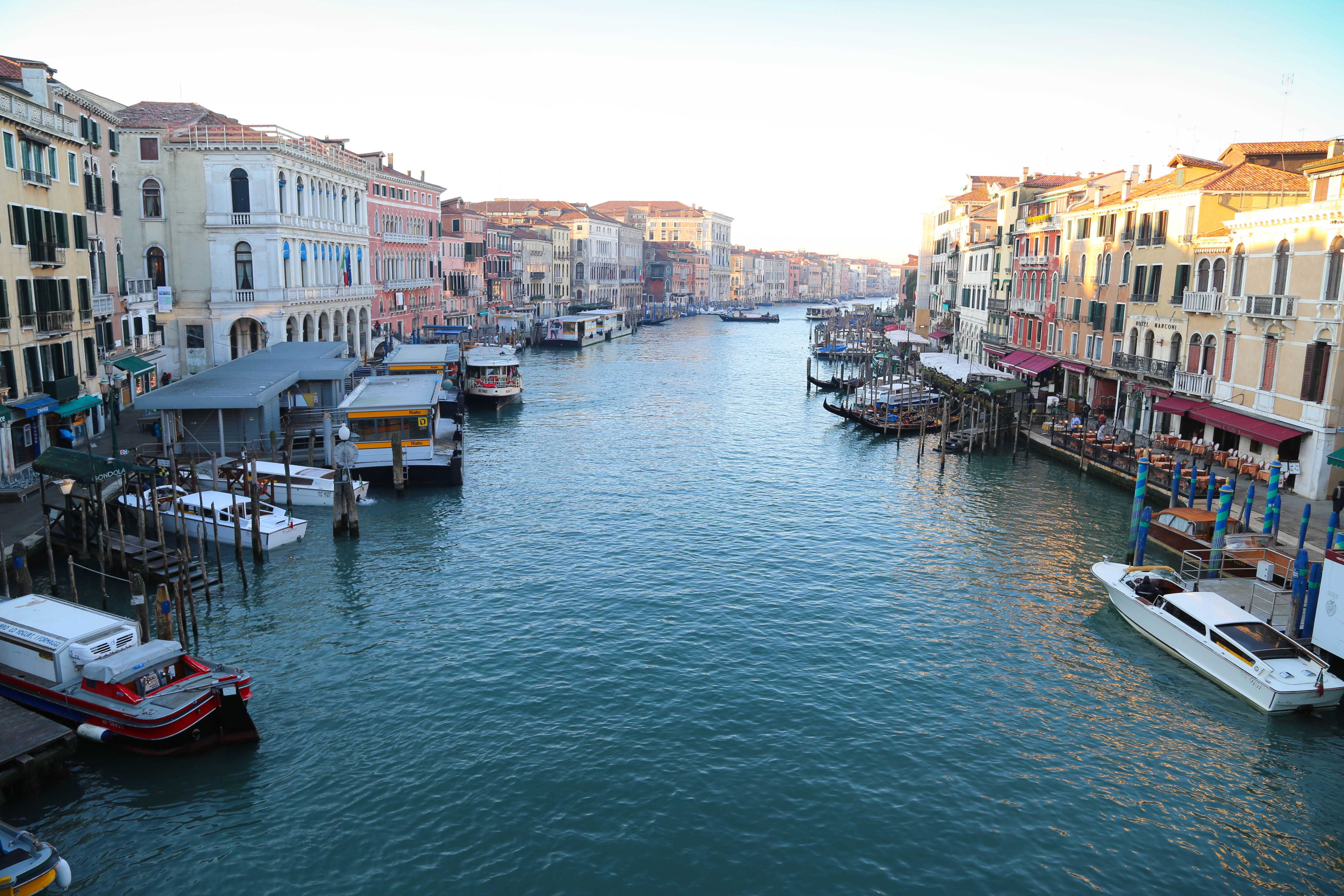
Before Venice stirs to life, the canals are quiet and serene. But soon, the day, and hence the activities, begin.

Morning traffic has picked up along the Grand Canal with ferries, water taxis, delivery boats, and private watercraft begin to churn up the water.

The wooden boat tied up to the dock would be akin to a classic car. They are as much status symbol as transportation. The painted poles can be seen throughout Venice and the various colors denote the address of the resident — and also that it’s reserved parking, or in the case of Venice, docking.
That cluster of islands proved to be a wise choice. Residents improved the land, dredged canals, built homes, and set up shop. Their expertise living and working on the water made them first rate sailors, traders, and producers of salt. The official founding of Venice was March 25, 421, the Catholic Feast of the Assumption, when the San Giacomo church on the isle of Rialto was dedicated. The residents chose St. Mark as the city’s patron saint and his symbol of a winged lion adorns the city’s emblem. Unknown to those early residents, the greatness of Venice was just getting started.
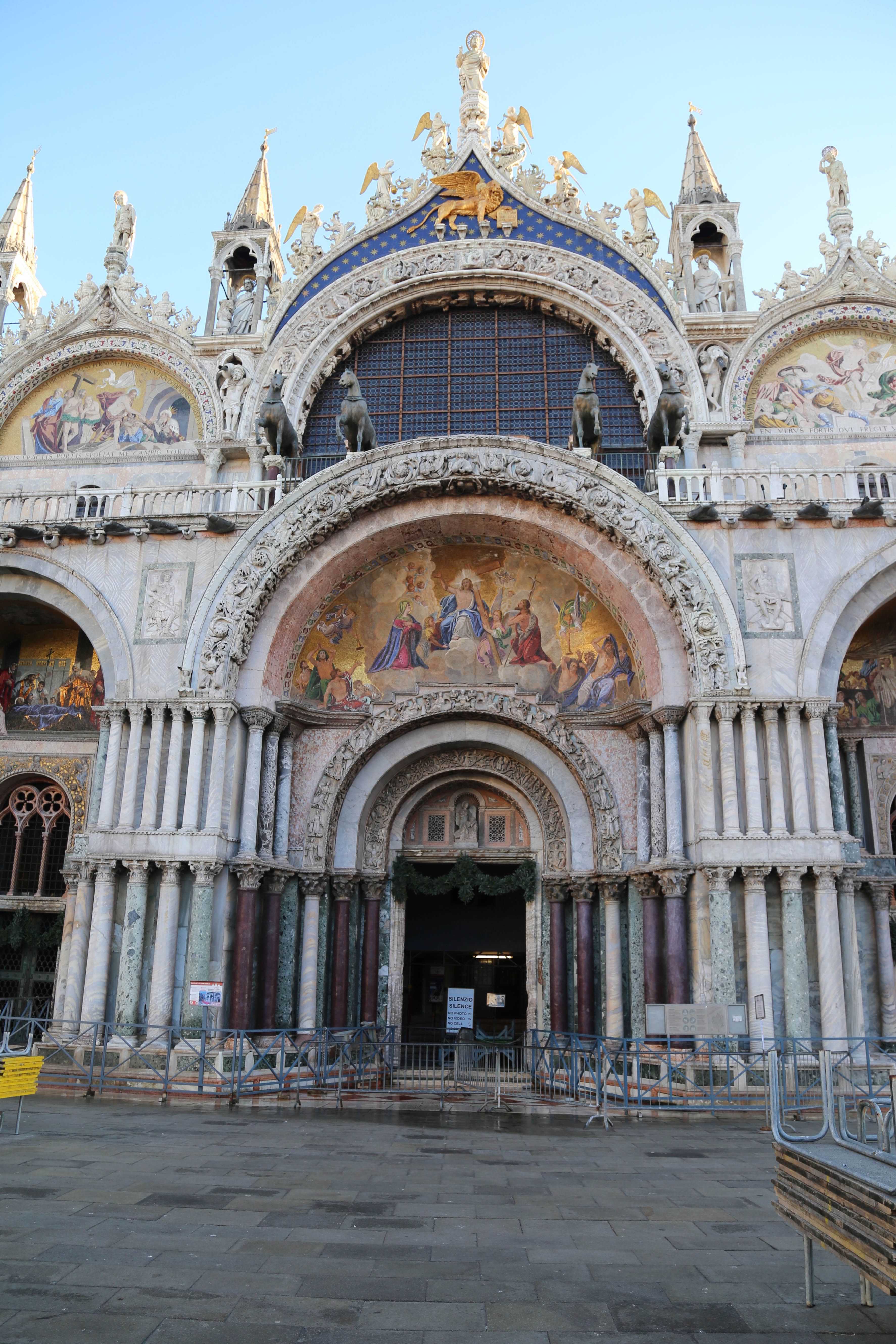
At the top of the arch of St. Mark’s Basilica is the emblem of St. Mark, a winged lion, and also the emblem of the city.
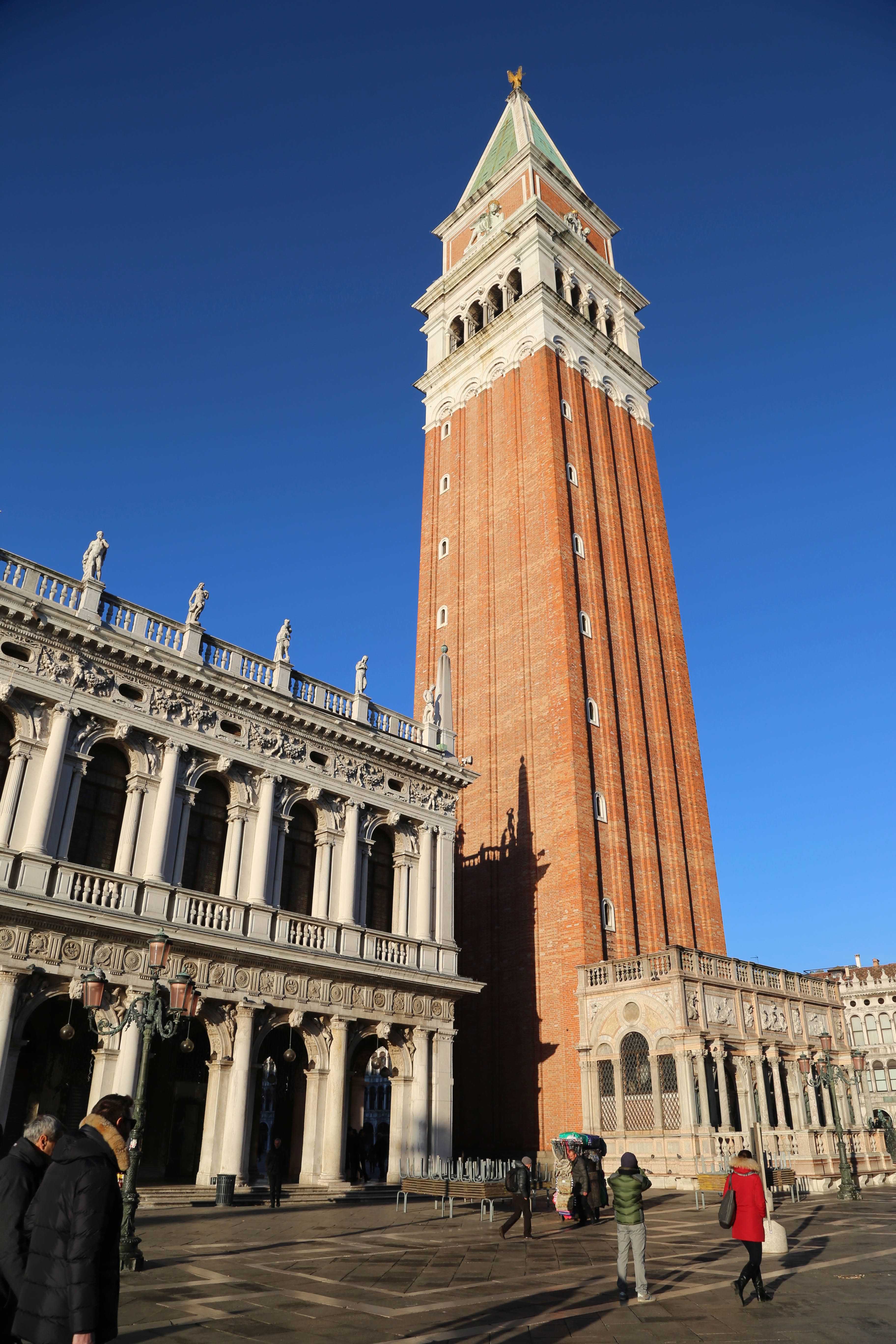
St. Mark’s Campanile is one of the most recognized symbols of Venice. It stands more than 323 feet tall at the corner of Piazza San Marco (St. Mark’s Square.)
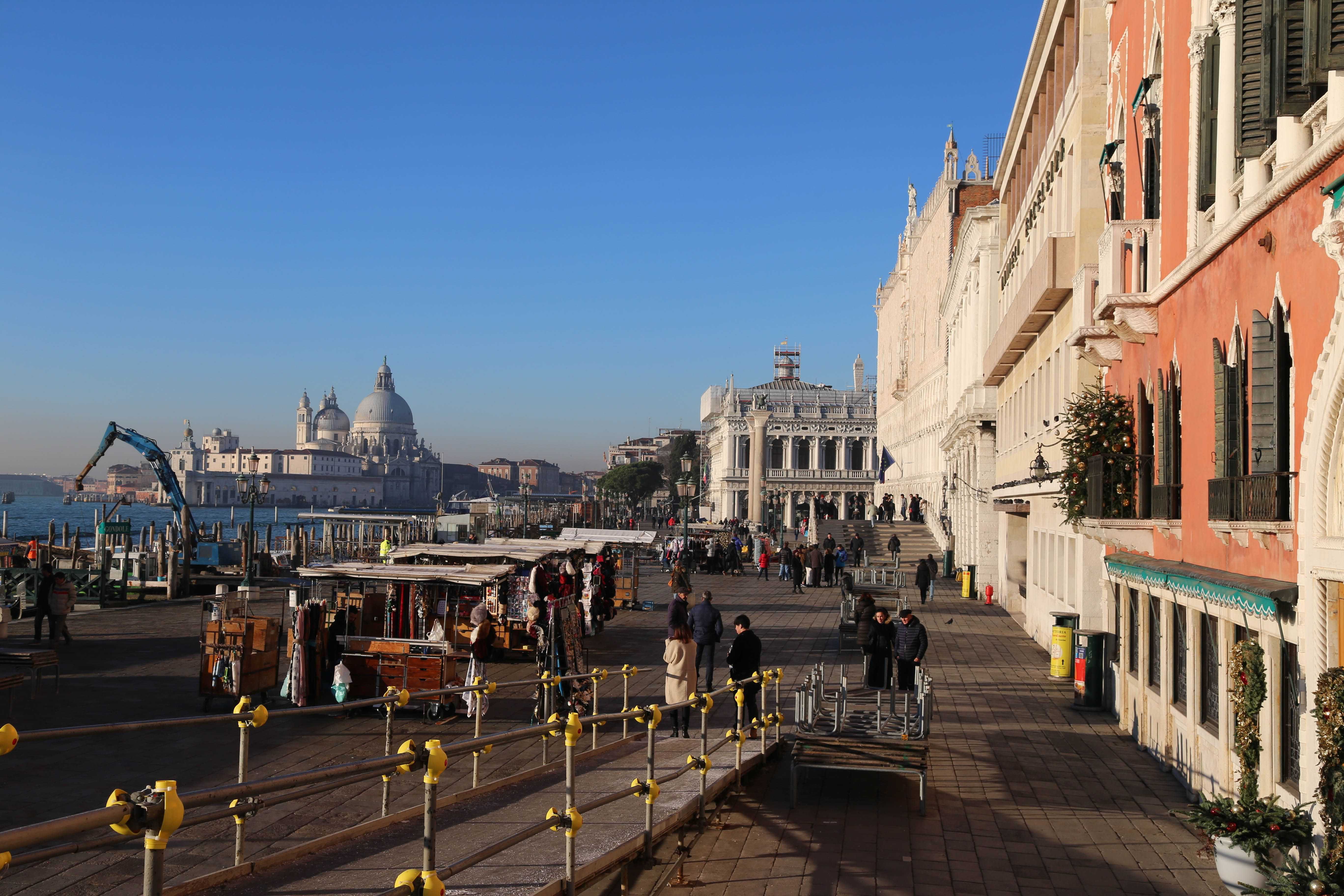
With tens of millions of tourists yearly, maintenance work occurs all over the city. At left, a pile driver removes and replaces wooden pilings used by gondolas and boats, as residents and tourists stroll past.
As trade routes grew and prospered, the city’s location became ever more strategic, as the people became more expert sailors, traders, and businessmen. Wealth flowed into the city. Venice became so prosperous and important that in 697 Venice it became the Venetian Republic, and would remain so until 1797. Though more a city-state than a nation, it was a vital trade and business link between Europe to the west and kingdoms to the east. At her height, there were 36,000 Venetian sailors with around 3,300 ships plying the waters of the Old World. It is often said war can be good for business and for Venice, The Crusades (March 1095 through June 1291), were no exception. Their conclusion created a business boom and greatly increased the city’s strategic location and importance for trade and commerce.

When it comes to keeping the city stocked with food, drinks, goods, and products, forget wheels — it’s all about keels. A pair of men toss and catch an order of goods to be delivered to the customer.

Morning deliveries are offloaded from tender boats and carried to the shops and businesses that will sell them to some of the 20 million or so visitors to Venice each year.
Venice has always had a keen focus on business and her leaders established a system of governance more like a modern corporation than a royal family. The leader was selected by a collection of elite families, leading businessmen, and respected traders. They selected a “Doge” who would serve for life. And the system worked remarkably well, thanks in part to checks and balances to protect against corruption, nepotism, and double dealing. The doges (dukes) were men of sterling character, already wealthy and successful, and they held the best interests of Venice uppermost in their hearts.

Ponte Rialto is the most famous bridge in Venice, as well as the oldest of the four bridges that span the Grand Canal. It was rebuilt several times over the centuries and first began as a pontoon crossing in the 12th Century. The shops along the span have not yet opened for the day’s business.

Some of the quintessential elements of Venice can be seen here — gondolas, the Rialto Bridge, the Grand Canal, the yellow stations to catch the water ferries, and buildings along the waterfront.

A gondola ride is one of the must-do activities in Venice. But be aware that a half hour ride can set you back 80 to 100 dollars. This larger group helps keep the per-person costs down a bit. If you want a longer ride, negotiate in advance.
The measure of wealth that flowed into the city is evidenced today by the magnificent buildings, palaces, villas, churches, and sheer beauty that are Venice’s hallmarks. When undertaking a new building project, cost was rarely an issue. More important was that a building, bridge, church or piazza be grand and beautiful, and that it cast Venice in the best possible light.

Perched atop the column, center right, is a sculpture of St. Mark as it keeps watch over the piazza. The motto St. Mark translates in English to, “Peace be with thee, O Mark, my evangelist.”

With only about 400 licensed gondoliers in Venice, who all dress the same, they all know each other. Here the man waiting for passengers chuckles with the gondolier making his way past along a narrow canal.

The piazza is quiet on an early morning of a winter’s day, and though simple, it shows a grace of design and beauty.
Many of the world’s great cities have a few golden years, but Venice had golden centuries – the 13th through the 17th. Shrewd Venetian businessmen developed highly sophisticated trading practices ensuring the city would be a respected center of trade. As examples, Venetians expanded the use of loans, credits, and payments so that transactions in one place could be paid for in another. In the 13th Century Venice was the most prosperous city in all of Europe, and in 1482 she was Europe’s printing capital.
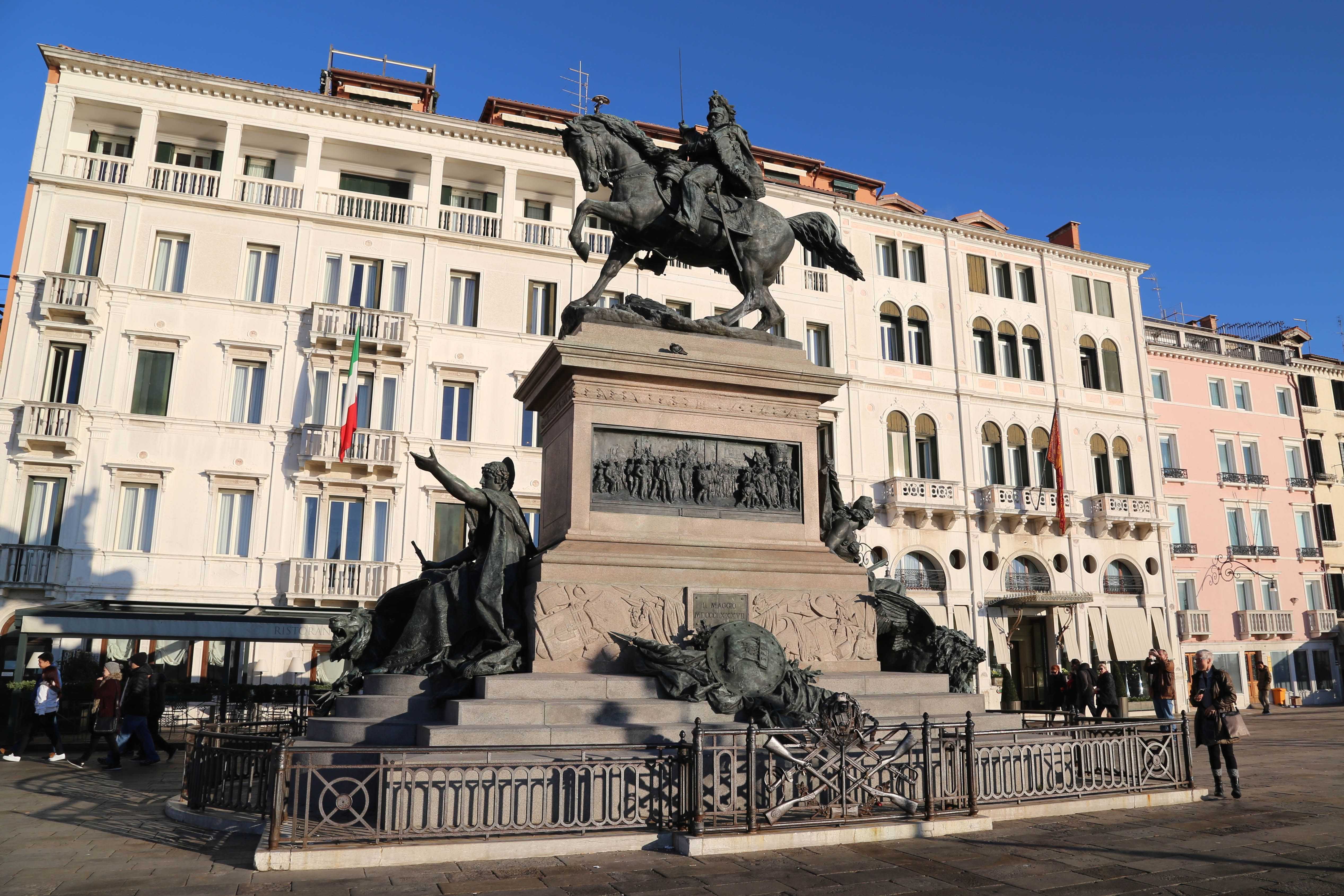
There are few grandiose statues in Venice, but this one, to honor King Victor Emmanuel II, serves as both tribute and remembrance of critical events in the city’s history. Victor Emmanuel II was the first king of a newly-united Italy, which occurred in March of 1861. The statue was erected in 1887.

Masks are one of the enduring symbols of Venice and are especially popular during Carnival, on Shrove Tuesday, the day before Ash Wednesday.
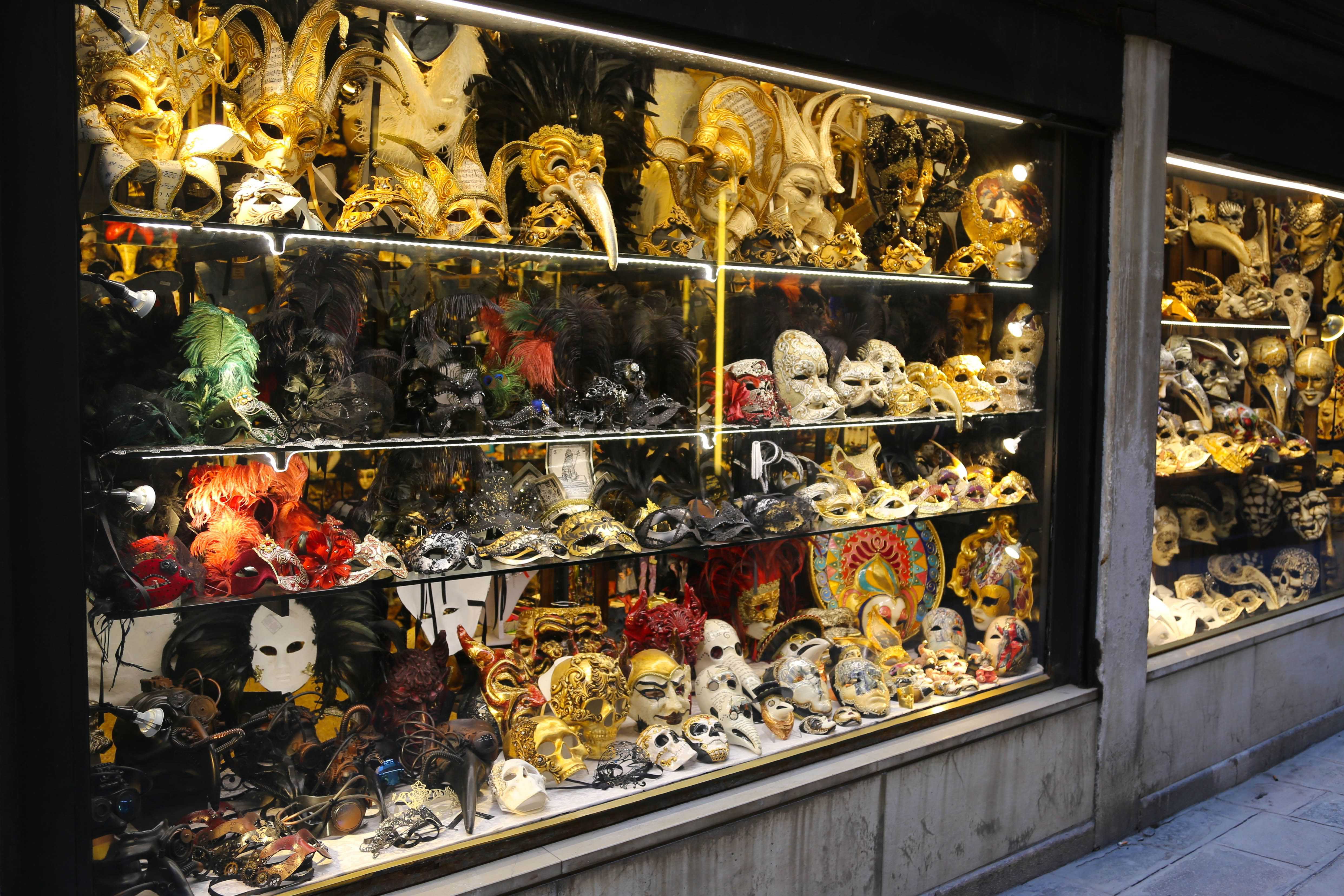
Upwards of three million revelers have jammed the streets and byways of Venice to celebrate Carnival. The masks were popularized as a way to conceal the identity and social status of the wearers.

Originally, the Carnival masks were made of Papier-mâché, so they were not made to last, and they could be quite elaborate.. Nowadays many masks are made of plastic.
Despite Venice’s incredible success, the changing nature of the world and business marked the decline of the city. In the 1600s the New World was an emerging area of international commerce and European nations were looking for opportunities in the Americas, Africa, around the Cape of Good Hope to India and Asia. Land routes across Asia and the Arabian Peninsula became the slow lane, compared the relative safety and speed of oceanic shipping lanes. Adding to the city’s woes was a plague (the city suffered 22 outbreaks of plague between 1361 and 1528), and the one from 1629 – 1631 wiped out nearly one third of Venice’s population. In 1797 Napoleon Bonaparte sacked the city and stole much of Venice’s wealth. Over the years control of Venice would drift from Austria, back to Italy, finally taking her place within the ‘new’ Republic of Italy in the 1870s.
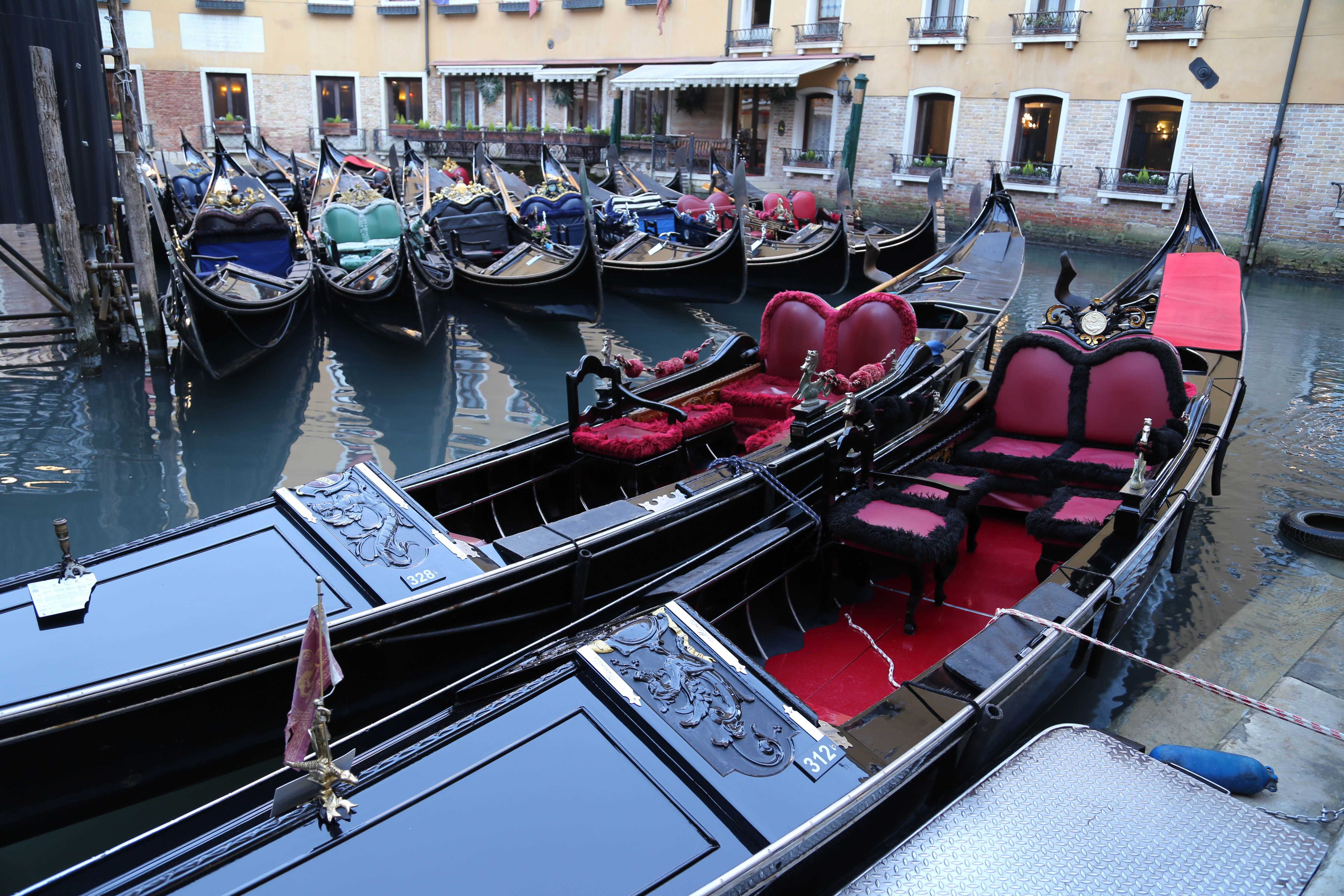
A fleet of gondolas float gently on the water, waiting for tourists to rouse and seek rides. At their height in the 1500s there were as many as 10,000 gondolas. Today there are only about 400, but the gondoliers can make a good living.
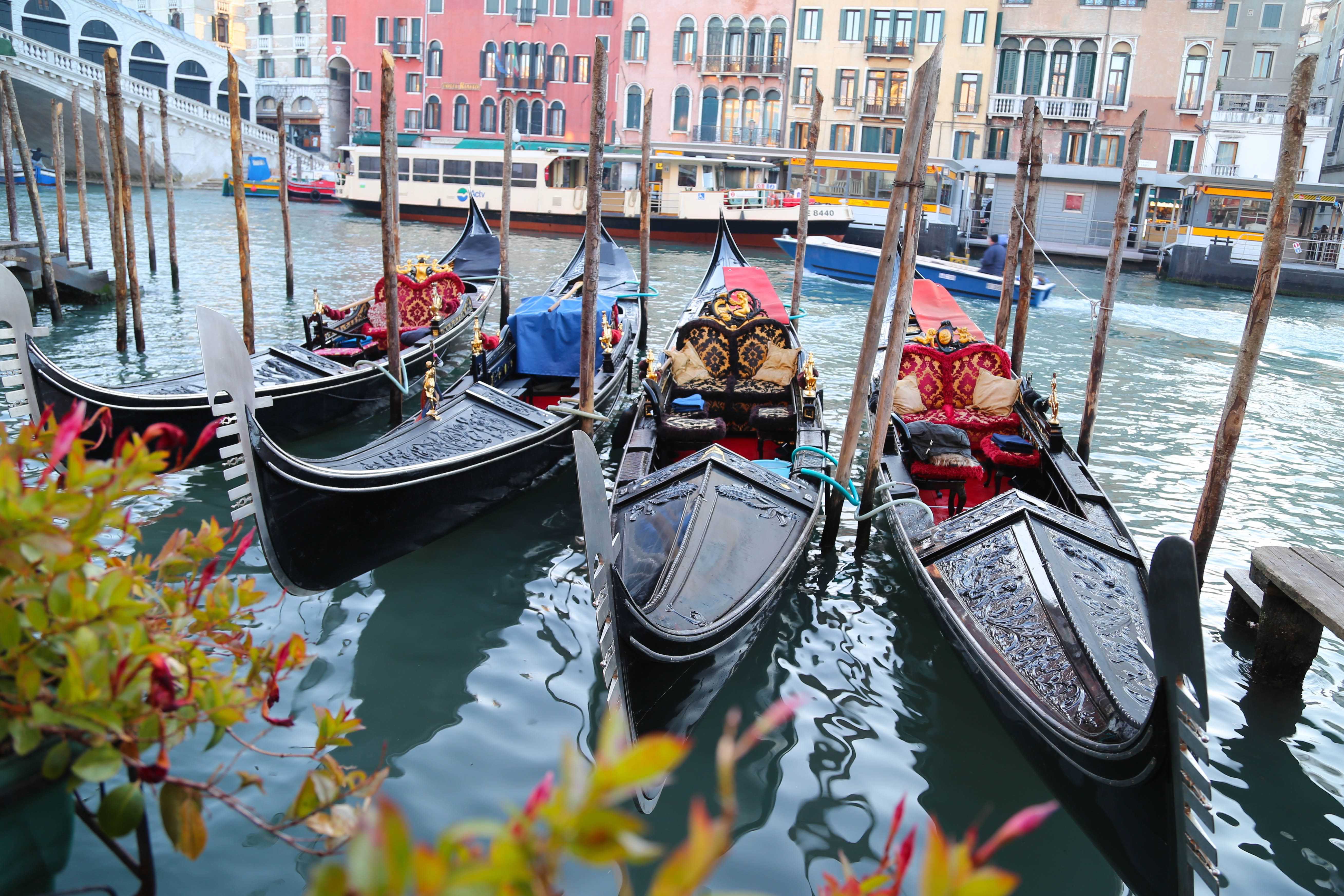
Each gondola is a work of art, made to exacting specifications that include the number of pieces of lumber in each boat, their length, width, and other dimensions.
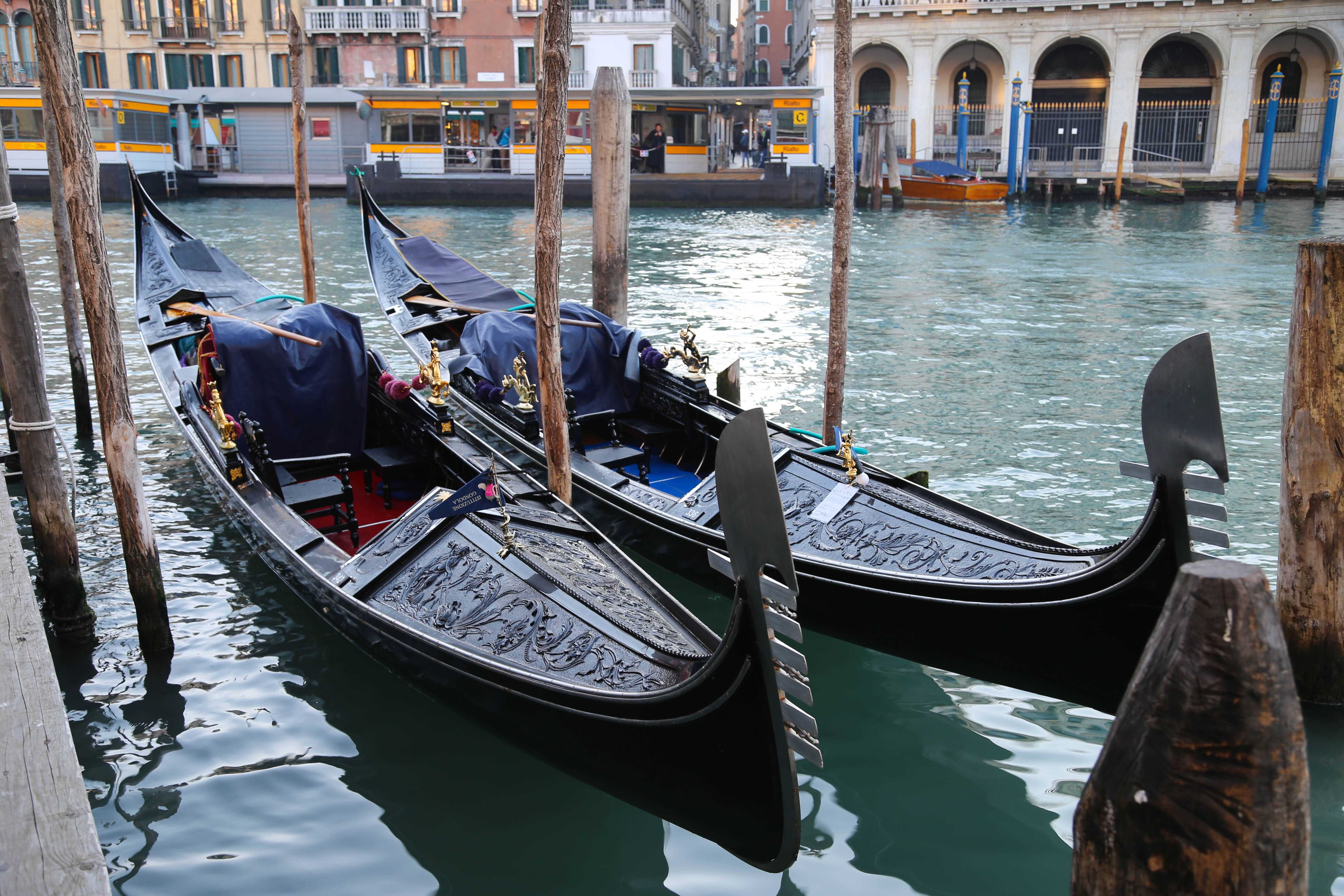
While each gondola may look the same from a distance, up close each is as unique as a human fingerprint. All of them have the comb prow and a seating area, but the carvings and woodwork are unique to each water craft.

It’s early and tourists, the main source of revenue for gondoliers, have yet to roll out of bed, so this fellow, outfitted in the traditional togs of the gondoliers, does what everyone does — he checks his smartphone.
Thankfully, the beauty and grandeur that was built up in Venice over a thousand-plus years still remains. The city is such an architectural gem that in 1987 UNESCO recognized Venice as a World Heritage Site. Just a few of the many, many magnificent buildings and structures that draw tens of millions of visitors to Venice each year are St. Mark’s Basilica, St. Mark’s Square, the Doges Palace, Bridge of Sighs, the Rialto Bridge, the Ca’ d’Oro, Santa Maria Gloriosa dei Frari, the Arsenal and Museum of Naval History, and Gallerie dell’Accademia (Fine Arts Museum).

The canals of the city require constant attention, and dredging boats regularly haul muck out of canals so they can maintain their depth.

In a city with canals, bridges, and millions of tourists, all manner of things fall into the water. This clever shopkeeper has turned trash into treasures, though the cameras will never again be taking photos.
Sadly, mixed in with all the beauty of Venice are some ugly reminders that great care needs to be taken to preserve the city. Venice is literally sinking from its own weight due to the instability of the lagoon’s mud bottom that supports the oak and larch wooden pillars holding up the city’s buildings and streets, and a rise in sea levels exacerbates the problem. The city now floods on a too-regular basis, covering streets and piazzas with a foot or more of water.

Gondoliers treat their boats with loving care. The gondolier must be licensed, properly attired, and have a boat that looks as good as the competition. A gondola can cost upwards of $40,000, and this man begins his morning by making sure his boat is clean and gleaming.

A gondolier guides his passengers along a quiet stretch of canal during an early morning ride.
Another significant problem is the sheer number of tourists pressuring the city. As many as 25 – 30 million people pour in each year, according to a UNESCO report, but only about one-third of them stay overnight. Streets, bridges, and venues become overwhelmed with visitors who often look but don’t buy anything.

Peak summer tourist season brings hordes of visitors and St. Mark’s Square can be packed with people, everyone trying to create a perfect picture memory. But the winter season offers some respite and this artist, lower right, has finished his painting of St. Mark’s Basilica, and can still see enough of his next subject, St. Mark’s Campanile, right, to paint his own perfect picture.

For tourists, a gondola ride can be something planned for, a device to propose marriage, or just an impulse to be enjoyed. This gondolier knows that sooner, rather than later, people will come up and ask for a ride.

When the morning light is right and the water is calm, Venice reflects back her beauty.
The local resident population who live on Venice’s island is shrinking. Apartment owners are cashing in on tourists demanding short term accommodations which drives up the price for longer term rentals that residents need. The population of the locals who do live there is aging, (35 percent is age 60 and older). Venice, like all of Italy is seeing declining birth rates, skewing the death rate upward. In the late 1960s the population living on the islands of Venice was greater than 170,000 people. Today, that population is fewer than 60,000 people.

As the sun begins to light the faces of Venice’s beautiful buildings a few people make their way to work and appointments, well before the tourists have stirred.
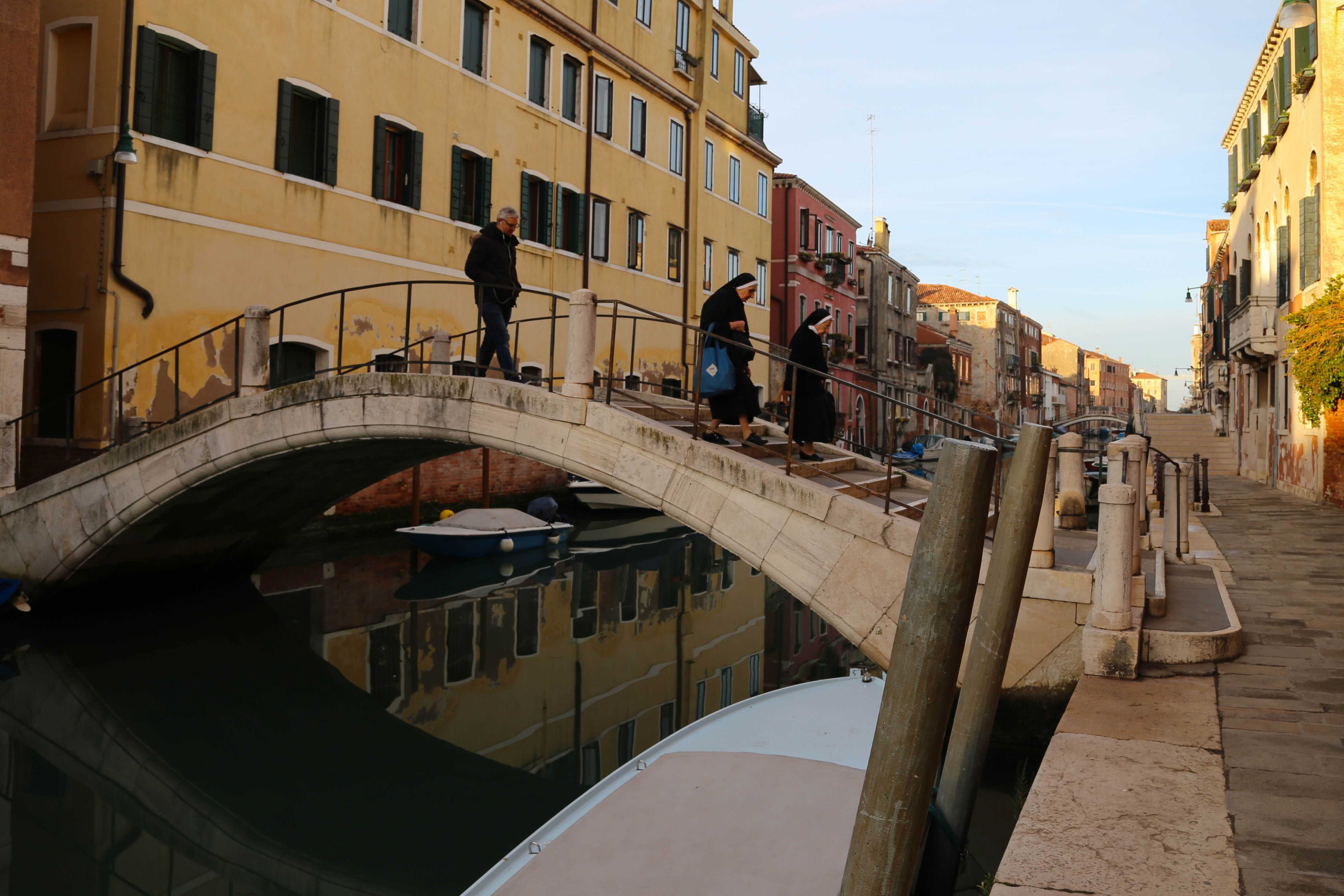
A pair of nuns and a man trailing behind make their way across one of the 400 bridges in Venice as they begin their day.

One of the delights of wandering the streets of Venice is that everywhere one looks, there is beauty at every turn.

Venice is a small city, just over three square miles, which is one reason there are no modern buildings in the city.

The Italians have a sense of design and aesthetic, and Venice is a leading example of form and function blending with beauty. This simple entryway off one of the canals is beautiful and welcoming.
Compounding the problem are cruise ships that add upwards of 1.4 million day-trip visitors annually, not to mention the additional air pollution from engines idling at the Port of Venice (the second largest facility in the Mediterranean). Residents of the city want to ban cruise ships from the Grand Canal and to charge a tax to all visitors who do not stay in the city overnight. The problems arising from cruise ship traffic to Venice have become so severe that UNESCO has threatened to reevaluate the city’s World Heritage status.

The cost of real estate and rents in Venice is driving many residents out. Small apartments can sell for several hundred thousand dollars or more and palazzos can easily run into the millions of dollars. Plus, there’s the cost of upkeep and the need to trade in your car for a boat.

The elements take their toll on the buildings of Venice, so you will often see structures in some state of renovation. This building looks to be in pretty good shape as the gondolier takes his passengers on a tour.
But Venetians love and treasure their city and determined factions are working passionately to preserve their home. The very idea of a city built on sticks in the middle of a muddy lagoon may be an improbable notion, but to the people who call Venice home, they are hopeful it is a foundation that will stand the test of time.
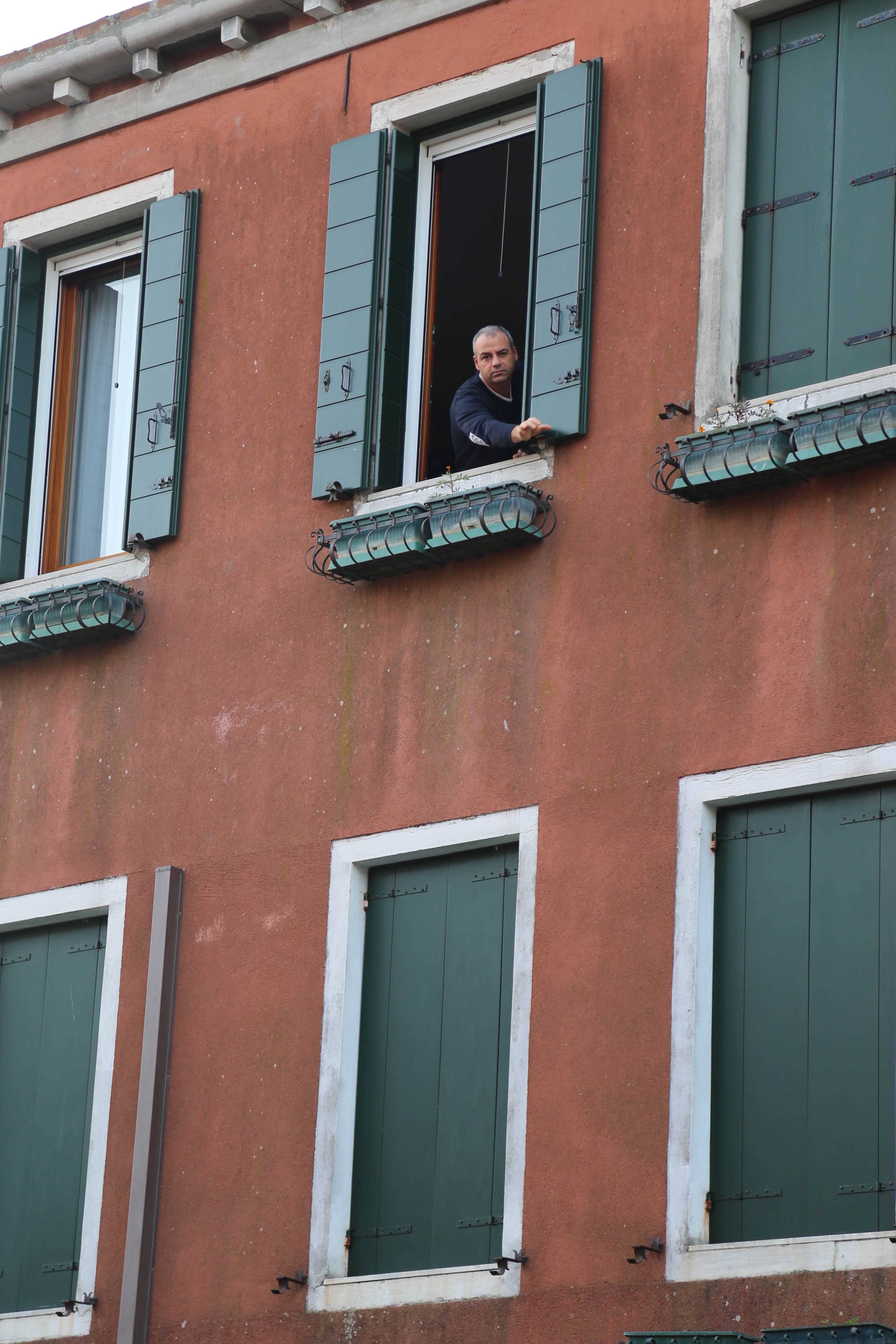
A man opens the shutters to start his day and let some light into the room.

The building in the center of this piazza is illustrative of “Venetian windows” with their peaks at the top of the arch. It is a style of window that can be seen in many places along the Adriatic coast and is evidence of the range and influence of the Venetian Republic.
For more information about Venice, visit these websites:
wikipedia.org/Republic_of_Venice
